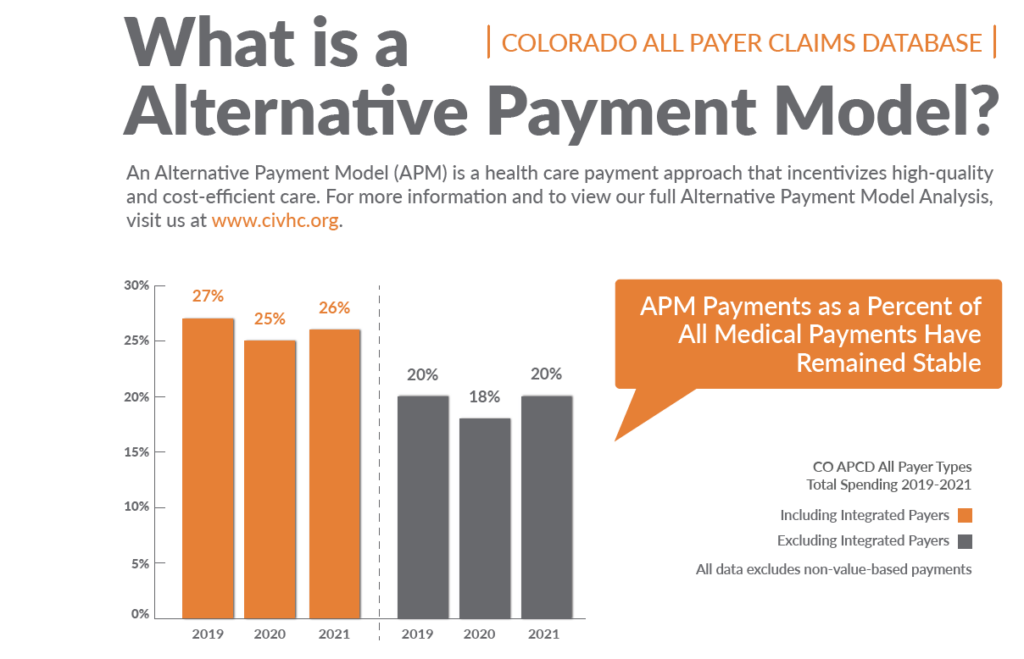A recent update to CIVHC’s Alternative Payment Models (APM) analysis shows that in 2021, across all health insurance payers in Colorado, 20% of all medical payments* were paid for outside of the traditional fee-for-service (FFS) model. Health insurer progress towards APMs is important to track as new payment models are regarded as one solution to save costs and improve patient outcomes. The new report finds that across all payers, APMs for overall medical payments (not including pharmacy and dental) remained stable from 2019-2021, while APM payments for primary care providers declined.
As health care costs continue to rise in Colorado, policymakers, providers, payers, and others are trying to incentivize value-based care, or care that is high quality, coordinated, and cost-efficient. Unlike the traditional FFS model, most APMs help promote value-based care since payments are generally based on the quality of care provided to patients as opposed to the volume. When used effectively, APMs can reduce health care spending and improve overall health and outcomes.
CIVHC first began collecting APM information in the Colorado All Payer Claims Database (CO APCD) from health insurance payers in 2019, when Colorado became one of the first states in the nation to collect this information. As part of HB 19-1233 CIVHC began providing the Primary Care Payment Reform Collaborative an annual analysis related to primary care spending and APMs in an effort to increase access and use of primary care services.
This most recent analysis indicates that the decline in APMs for primary care may be driven by a decrease in spending in the APM categories that include value-based payments, or payments that include a quality of care component. Findings related specifically to value-based APMs include:
- In 2021, nearly 70% of all APM payments for primary care were considered “non-value-based” (excluding non-integrated providers), and NOT tied to patient outcomes or quality of care
- From 2019 to 2021, across all payers, value-based APMs:
- As a percent of total primary care spending, dropped from 20% to 16%*
- As a percent of all medical payments remained steady at 20%*
“Understanding whether Colorado is maintaining momentum in lowering health care costs and improving care, and where efforts may be lagging is vital,” notes Cari Frank, CIVHC’s Vice President of Communication and Marketing. “The journey towards alternative payment models is a marathon, not a sprint, and even though we may not be making progress as fast as we’d like to, we need to continue to push towards the ultimate goal of making the health care system more accessible and equitable for all Coloradans.”
Additional insights include:
- For commercial payers, 16%* of all primary care payments were paid for through an APM in 2021
- The top APM category, excluding integrated payer-provider systems, spend in 2021:
- For all payers was Pay for Performance, and accounted for 57% of APM spending for medical payments
- For commercial payers was APMs with Shared Savings, and accounted for nearly 50% of all APM spending for medical payments
Further insights, trend data, and information on the use of specific APM types can be found in the interactive report on CIVHC’s Affordability Dashboard, including an issue brief, and an infographic. For questions about the report or APM collection, please contact CIVHC at info@civhc.org.
*Excludes payments by integrated payer-provider systems, and non-value based payments. Several Colorado payers are structured as integrated payer-provider systems and have a high portion of APM payments compared to other commercial payers. These payers represent around a quarter of the commercially insured lives in Colorado.
About CIVHC
CIVHC helps a diverse range of individuals, communities, and organizations make informed decisions to reduce health care costs and health inequities while improving the health and lives of Coloradans. We have a number of transparency tools available including:
- Shop for Care
- Provider Payment Tool
- Affordability Dashboard (Low Value Care, Drug Rebates, and more)
- Telehealth Services Analysis
